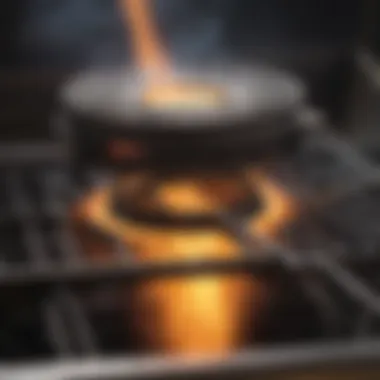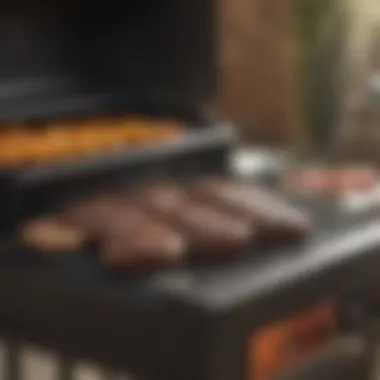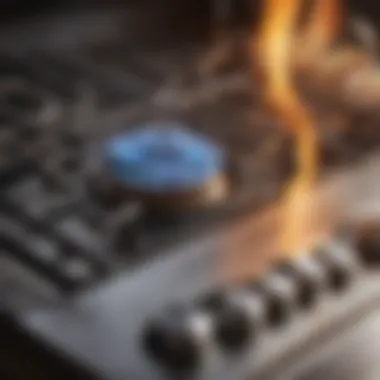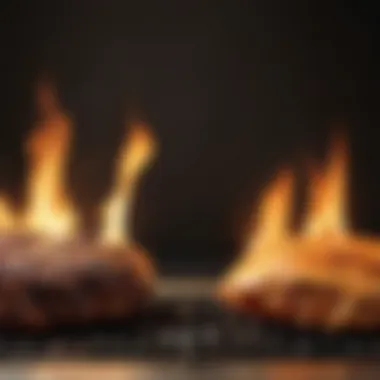Troubleshooting Low Flames in Gas Grills: A Guide


Intro
Low flames in gas grills can be frustrating for anyone who enjoys outdoor cooking. When grilling, a reliable flame is essential for achieving the desired temperatures for cooking various foods. Although often overlooked, the flame intensity can have a significant impact on the overall grilling experience. In this article, we will dissect the potential reasons for low flames, offer solutions, and discuss maintenance practices to keep your grill functioning optimally.
Understanding the technical aspects of gas grills is beneficial. The grill's components work together to create the flame that cooks your food. When any part of this system fails, it can lead to reduced flame height and inconsistent cooking temperatures.
Another crucial aspect to consider is fuel management. Using proper gas sources and monitoring fuel levels can prevent many problems associated with low flames. Engaging in regular maintenance practices can also reduce the likelihood of encountering flame issues.
By the end of this guide, readers will have the tools to diagnose and resolve low flame problems in their gas grills, ensuring a smoother, more enjoyable cooking experience.
Understanding Gas Grill Flames
Understanding the flames in your gas grill is essential for an optimal grilling experience. The flame’s height and consistency can affect cooking performance and food quality. Low flames typically signal underlying issues that could compromise your ability to grill effectively. By recognizing the properties of gas grill flames, you gain insights into troubleshooting and serving well-cooked meals.
The Importance of Flame Height
Flame height is a critical factor in the grilling process. A flame that is too low may not provide sufficient heat for cooking food properly. This can lead to uneven cooking, prolonged meal prep time, or even undercooked food, posing health risks. Contextualizing flame height helps grill users understand the temperature range that different foods require. For instance, searing meats often demands a high flame to achieve that preferred crust, while simmering or slow cooking requires less intensity.
Controlling the flame height also influences the flavor development of your dishes. The right flame can facilitate the Maillard reaction, enhancing browning and delivering deeper flavors. Moreover, a well-regulated flame contributes to a pleasant grilling atmosphere, reducing frustration during outdoor cooking. By being aware of these elements, users can appreciate the nuances of flame management.
Typical Flame Characteristics
Typical gas grill flames should exhibit a vibrant blue color, which indicates proper combustion. The blue hue signifies that the fuel is burning efficiently, ensuring that the grill reaches the desired temperatures for cooking. In contrast, yellow or orange flames may suggest incomplete combustion. This can indicate that something is wrong, possibly relating to gas supply or burner conditions.
A healthy flame typically dances gently but does not flicker dramatically. If flames appear to be flickering too much, check for issues such as wind interference or gas misfires. Consistent flames create an even cooking surface, which is essential for proper grilling. Also, when the flames are stable, it aids in planning the cooking time for your dishes, allowing for precise meal preparation.
In summary, understanding gas grill flames is crucial for anyone aiming to enhance their grilling skills. Familiarity with the characteristics and importance of flame height paves the way for better results and more enjoyable cooking experiences.
Common Causes of Low Flame
Understanding the common causes of low flame in gas grills is vital for any enthusiast looking to achieve the perfect grilling experience. Low flames can significantly affect cooking efficiency, leading to uneven heating or undercooked food. Moreover, recognizing the cause can save time and effort, preventing frustration during outdoor cooking.
Several elements can contribute to low flame issues in gas grills. Each potential cause needs attention and analysis. By identifying these causes, grill owners can approach resolution with confidence. This part examines the primary factors that may hinder optimal flame height.
Gas Supply Issues
Gas supply problems are among the primary reasons for low flames in gas grills. These issues can stem from a variety of sources. First, ensure the propane tank or natural gas line is not empty or restricted. An empty tank means no gas reaches the burners, resulting in an inadequate flame.
Moreover, check for leaks in the gas line. A faulty connection can cause gas to escape before reaching the burners, impacting performance. Regular inspections and careful handling of the gas lines are crucial. If a noticeable smell of gas appears, it is vital to shut off the supply and consult a professional.
Clogged Burner Ports
Clogged burner ports can frustrate grill users by significantly limiting meal preparation. Over time, grease, food debris, and even insects can obstruct these ports. Blocked burners will not allow gas to flow properly, which reduces flame height.
The problem usually becomes evident during cleaning periods. Inspecting the burner ports is essential. A simple cleaning can often resolve this issue. Use a narrow wire or a brush to clear obstructions. Be mindful to avoid damaging any parts during this process.
Malfunctioning Regulator
The regulator plays a crucial role in controlling the flow of gas from the tank to the burners. When it malfunctions, the flame can be diminished. Symptoms of a malfunctioning regulator may include an inconsistent flame or difficulty starting the grill.
It's advisable to check the regulator regularly for any visible signs of damage or wear. Evaluation may entail looking for cracks or deformities in the structure. Sometimes, the solution might be as straightforward as resetting the regulator or replacing it entirely. Inspecting this component is essential for maintaining proper gas flow.


Dirty or Damaged Ignition System
An ignition system that is either dirty or damaged can also result in low flames. If the grill takes longer than usual to light or fails to ignite properly, there could be an issue with the spark module or the electrodes.
Keeping the ignition system clean is straightforward. Remove any debris around the ignite area and ensure all components are functioning. Testing the ignition manually can also provide clarity. If necessary, replace any damaged parts. Ensuring a well-functioning ignition is critical to maintain steady flames.
Overall, assessing these common causes leads to a better understanding of the internal workings of gas grills. This familiarity can enhance the grilling experience. By addressing issues like gas supply, clogged burner ports, malfunctioning regulators, and ignition system cleanliness, users can improve performance immediately.
Diagnosing Low Flame Problems
Diagnosing low flame problems is crucial for any gas grill user. When low flames occur, it often means there is an issue that needs attention. Understanding how to identify and evaluate these problems can prevent further damage and improve the overall grilling experience. A methodical approach ensures that potential hazards are minimized and the grill performs optimally. By knowing how to troubleshoot low flame issues, users save time and money while enjoying their food preparation.
Initial Preparations
Before diving into the diagnostic process, it is essential to prepare adequately. Ensure the grill is off and cool to prevent injury. Gathering the right tools is necessary: a screwdriver, brush, and multimeter can be helpful in the inspection process. Make sure to read through the grill's manual. The manual offers specific details on the model, which can provide insight into any built-in features or mechanisms that may differ from general configurations.
Key steps in initial preparations:
- Turn off the gas valve and disconnect if needed
- Allow the grill to cool down completely
- Gather necessary tools for inspection and testing
- Review the grill's user manual for model-specific instructions
Visual Inspections
Visual inspections serve as the next phase in diagnosing low flame issues. Check for any visible signs of blockages or damage. Focus on the burners and ensure they are clean and free from debris. Look for any signs of rust or corrosion on components, which may hinder performance. A well-maintained grill typically has clean and aligned burner holes.
Beyond the burners, consider inspecting the gas lines for leaks. A simple way to check for leaks is using a soapy water solution. Apply it to the connections, and if bubbles form, gas is escaping.
Important note: Addressing visible damage immediately can help prevent further complications down the line.
Testing Gas Pressure
Testing gas pressure is a critical step in determining the cause of low flames. A pressure gauge can help measure the rate of gas flow. Connect the pressure gauge to the grill in accordance with the manufacturer’s instructions. It is vital to have the grill turned on during the test, allowing for accurate readings.
The ideal gas pressure specifications can vary, depending on the grill make and model. Compare your readings against these standards. If the pressure is lower than the recommended level, it could indicate problems related to your gas supply or the regulator.
Steps to test gas pressure:
- Turn on the grill and remove the pressure tap (if applicable)
- Connect the pressure gauge carefully
- Read the gauge carefully while the grill is in operation
- Compare with manufacturer specifications
- Disconnect and replace the pressure tap after testing
By conducting these initial steps, you can effectively diagnose low flame issues in gas grills. This process will lead towards resolving and enhancing the overall functionality of the grill.
Resolving Low Flame Issues
Adjusting Gas Flow
Gas flow regulation is a vital aspect when it comes to achieving the appropriate flame height. A low flame may be a direct result of insufficient gas reaching the burners, which can affect the grilling process significantly. Regularly inspect the flow settings of your grill. Look for the control knobs that regulate gas flow to each burner. Ensure that they are set correctly to allow sufficient gas to pass through.
Also, remember to check the gas supply lines. Sometimes, the issue could stem from a kinked or blocked line. Ensuring a clear and open gas path can quickly solve low flame issues. If necessary, consult your grill's manual for specific instructions on adjusting gas flow settings. Ensuring the correct gas flow not only optimizes the flame height but also promotes safe operation.
Cleaning Burner Components
Another common cause of low flames is the accumulation of dirt and debris in the burner components. Over time, residue can clog the burner ports, leading to diminished gas flow. Cleaning these components regularly helps maintain proper function.


To clean the burners, first ensure the grill is turned off and cool. Remove the burners according to the manufacturer’s guidelines. Use a soft brush or a toothpick to clear any visible blockages in the burner ports. You might also wash the burners with soap and water to eliminate grease and accumulations. After cleaning, reassemble the burners carefully and make sure they are securely attached. Regular maintenance in this area can prolong the life of your grill and ensure an even flame.
Replacing Damaged Parts
In some cases, low flames result from fault or damage within the grill's components. If adjusting gas flow and cleaning do not resolve the issue, consider inspecting parts such as the regulator or valves. A malfunctioning regulator can lead to improper gas pressure and contribute to low flames.
Key indicators that parts might need replacement include:
- Unusual hissing sounds.
- Visible damage or corrosion.
- Inconsistent flame behavior.
Replace any damaged or malfunctioning components promptly. It is wiser to invest in genuine replacement parts that adhere to the manufacturer's specifications for compatibility and performance. By ensuring all components are in optimal condition, you can significantly enhance your grill's performance.
Regular maintenance and prompt repairs are essential for keeping your gas grill functioning effectively and safely, thereby greatly enhancing your grilling experience.
In summary, addressing low flames is a multi-step process involving careful adjustments, cleaning, and component checks. By focusing on these areas, you can revitalize your grill, ensuring it works efficiently and safely for your culinary endeavors.
Preventive Maintenance for Gas Grills
Preventive maintenance is a crucial aspect of gas grill ownership. Regularly maintaining your grill can prevent many issues, particularly low flames. This section emphasizes the importance of taking proactive measures. Doing so helps ensure not only the efficiency of the grill but also enhances safety. Well-maintained grills provide a better cooking experience and can extend the lifespan of the appliance. Moreover, it can save you money on repairs by catching potential issues before they escalate.
Regular Cleaning Routines
One of the most effective ways to maintain a gas grill is through regular cleaning. A well-cleaned grill prevents soot buildup, which can lead to low flames or uneven heat distribution. To start, ensure you clean the grill grates after each use. This will prevent food residue from accumulating.
At least once a month, deeper cleaning is recommended. This includes:
- Removing and cleaning the burner covers.
- Checking for rust or damage on grill parts.
- Clearing grease catchers and containers.
This prevents grease fires and improves airflow to the burners. Using a grill brush can help dislodge trapped debris.
Inspecting Fuel Sources
Inspecting fuel sources is essential in maintaining a gas grill. A reliable fuel supply—either propane or natural gas—is crucial for optimal flame performance. Regular checks can help ensure that there are no leaks or blockages. If using a propane tank, ensure it’s properly connected and full.
For natural gas users, visually inspect the gas line for any signs of wear or damage. It's advisable to conduct a soapy water test at the connections. If you see bubbles forming where the gas is connected, a leak is present. This requires immediate attention before any grilling can occur.
Routine System Checks
Routine system checks involve assessing various components of the grill systematically. Regularly check the ignition system to ensure it functions properly. If you notice issues like delayed ignition or weak sparks, it may indicate a need for cleaning or replacement.
Moreover, monitoring the regulator is important. It plays a significant role in maintaining consistent gas pressure, which directly influences flame height. Adjust the regulator periodically to keep the gas flow optimal.
Lastly, do not forget to inspect burners. Ensure they are clear of any blockages. Burners should show no signs of rust or corrosion.
"Preventive measures not only enhance the longevity of your grill but also assure consistent cooking performance."
By following these preventive maintenance practices, you can minimize the chances of experiencing low flame problems in your gas grill. A little time spent on maintenance can lead to a vastly improved grilling experience.
Understanding Grill Components
Understanding the components of a gas grill is essential for any grill user, especially when dealing with issues like low flames. The functionality and performance of the grill depend on how well each part works together. Knowledge of these components helps users diagnose problems and take informed actions. It can also assist in extending the lifespan of the grill through better maintenance strategies.
Burners and Their Roles


Burners serve as the core element that produces heat in a gas grill. They are usually made of stainless steel or cast iron and come in various shapes and sizes. A properly functioning burner should evenly distribute flame, ensuring consistent cooking temperatures across the grilling surface.
Some key aspects to consider include:
- Material: Stainless steel is more resistant to rust compared to cast iron, but cast iron retains heat longer.
- Design: Different burners like tube, H, or infrared burners serve unique cooking styles. Understanding these can guide your grilling decisions.
- Maintenance: Regular cleaning of burners is essential to remove grease and debris that can clog the ports. This is critical for achieving optimal flame height.
If the burners are not functioning well, low flames or uneven heating can occur, severely affecting the grilling outcome.
The Regulator's Function
The regulator is a crucial component in managing the gas supply to the grill. It reduces high pressure from the gas line to a safe and suitable level for the grill's use. This regulation is vital to maintain flame consistency and prevent potential safety hazards.
Considerations for the regulator include:
- Pressure Control: The regulator ensures that the grill receives the correct amount of gas, influencing flame height and stability.
- Safety Features: Most modern regulators have built-in safety measures to prevent gas leaks, enhancing overall user safety.
- Adjustment and Replacement: If you suspect your flames are low due to gas pressure issues, checking the regulator is crucial. It may need adjustment or replacement, depending on wear and tear over time.
Understanding these components can significantly improve the user experience by ensuring optimal conditions for cooking.
Overall, grasping the importance of these grill parts enables users to troubleshoot effectively and maintain their grills, thus enhancing their grilling experience.
When to Seek Professional Help
Recognizing Complex Issues
Low flames may sometimes indicate underlying issues that are not immediately fixable. Here are key signs that suggest it's time to call in a professional:
- Persistent Low Flames: If adjustments and cleaning do not rectify the flame issue, this may hint at a more intricate problem.
- Unusual Noises: Hissing or popping sounds while operating the grill could signify gas leaks or irregular pressure.
- Physical Damage: Visible cracks or damage to components like hoses or valves may necessitate professional repair.
- Flame Color Changes: A yellow or orange flame instead of a blue one can point to incomplete combustion, potentially toxic.
Recognizing these indicators early can help prevent further damage and ensure a safe grilling experience. It is crucial to understand that not every issue is something an average user can fix with basic tools.
Choosing a Qualified Technician
Choosing the right technician is essential for safe and effective repairs. Here are some factors to consider:
- Certification and Experience: Look for technicians who are certified in gas appliance repair. Experience can often make a significant difference in resolving complex issues.
- Reputation: Research online reviews and ask for recommendations. Technicians with a strong local reputation are often reliable.
- Clear Estimates: A reputable technician should provide a clear estimate before starting any work. This includes labor and parts costs to avoid unexpected expenses later.
- Warranty Offers: Technicians who offer warranties on their work can give you peace of mind. This indicates confidence in their repairs and commitment to quality.
"When faced with persistent grill issues, it is better to involve a skilled technician than to risk safety or further damage to your grill."
Finale
The importance of the conclusion in this article lies in its capacity to encapsulate and reiterate the critical insights surrounding low flames in gas grills. The topic encompasses a range of elements, from understanding the fundamental mechanics of gas grills to diagnosing and resolving low flame issues. By distilling the information presented throughout, readers can easily identify the key takeaways necessary for maintaining and enhancing their grilling experiences.
Summary of Key Points
In summary, several vital points about low flames in gas grills emerge from the discussion:
- Flame Characteristics: Understanding the typical flame characteristics and their significance provides a baseline for identifying problems.
- Common Causes: Recognizing the most prevalent reasons for low flames, such as gas supply issues, clogged burner ports, or malfunctioning regulators, is crucial.
- Diagnosis & Resolution Steps: Following a systematic approach for diagnosing and fixing low flame issues ensures comprehensive maintenance and prolongs the life of the grill.
- Prevention: Implementing regular maintenance practices like routine inspections, cleaning, and component checks can prevent low flame problems from arising.
"Regular maintenance not only enhances performance but also extends the life of your grill."
Final Recommendations
To adequately manage low flames in gas grills and maximize grilling satisfaction, consider the following recommendations:
- Prioritize Maintenance: Adopt a schedule for regular cleaning and inspections to catch potential issues early.
- Educate Yourself: Understand the workings of your specific grill model, including all components and how they interact.
- Act Promptly: When facing low flame issues, diagnose first, and resolve through cleaning, adjustment, or replacement of parts as necessary.
- Seek Help When Needed: If a problem appears too complex, engage a qualified technician to prevent further complications.
By following these recommendations, enthusiasts can ensure efficient operation and enjoyable grilling experiences.















